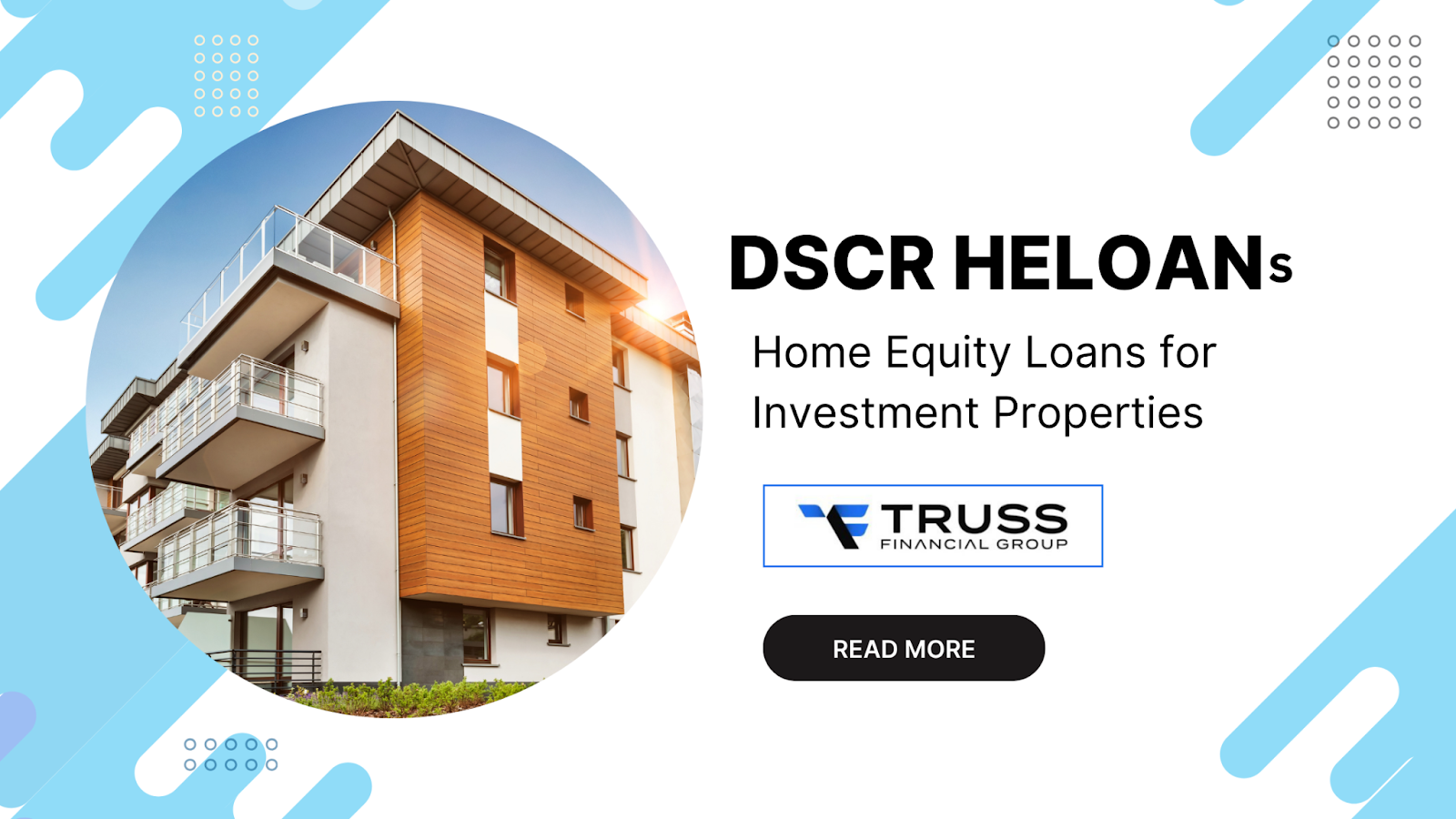20 min read

A DSCR HELOAN (Debt Service Coverage Ratio Home Equity Loan) lets real estate investors unlock equity from their rental properties without verifying personal income or refinancing their first mortgage.
Lenders qualify based on the property’s cash flow (DSCR = Rent ÷ PITIA) instead of W-2s or tax returns.
Key Points:
-
Built for investment properties only, not primary homes.
-
Functions as a second mortgage, preserving your existing low rate.
-
Typical LTV up to 70%, DSCR ≥ 1.0, and credit score 640+.
-
Funding up to $500K, often closing within 10–15 days.
-
Ideal for self-employed and portfolio investors seeking no-income-verification financing.
-
Funds usable for renovations, portfolio expansion, or debt consolidation.
Even if your DSCR is below 1.0, Truss Financial Group can help through asset-depletion and custom non-QM programs, making us one of the few lenders specialising in low-DSCR and non-traditional income scenarios.
DSCR HELOAN vs DSCR Cash-Out Refi
-
HELOAN = keeps first mortgage intact, faster close, lower costs, lower LTV.
-
Cash-out refi = larger loan amounts, single payment, potentially lower rate.
DSCR HELOAN vs. HELOC
-
HELOAN = Fixed lump-sum second mortgage.
-
HELOC = Revolving line of credit.
Both can use DSCR-based underwriting on rental properties.
Real estate investors constantly search for smart financing solutions that help them grow their portfolios without draining personal income or refinancing existing mortgages.
According to the National Association of Realtors, investor purchases continue to represent a significant portion of the housing market, making specialised financing options increasingly important.

DSCR HELOANs is a specialised financial product that allows property investors to tap into their rental property equity based on the income the property generates, not personal earnings.
This comprehensive guide explores everything you need to know about DSCR HELOANs, from how they work to their benefits, requirements, and application process.
What Is a DSCR HELOAN?
A DSCR HELOAN (Home Equity Loan) is a type of second mortgage designed specifically for investment properties. Unlike traditional home equity loans that require extensive personal income documentation, DSCR HELOANs focus on the property's rental income and its ability to cover debt obligations.
The term DSCR stands for Debt Service Coverage Ratio, a financial metric used by lenders to assess borrower capacity that compares a property's gross rental income to its total monthly expenses, including principal, interest, taxes, insurance, and HOA fees (commonly abbreviated as PITIA).

How DSCR HELOANs Differ from Traditional Home Equity Loans?
Traditional home equity loans evaluate your personal income, employment history, tax returns, and debt-to-income ratio. DSCR HELOANs take a different approach by examining the property's cash flow instead of your W-2s or tax documents.
This distinction makes DSCR HELOANs particularly valuable for real estate investors who may have complex financial situations, multiple income streams, or significant tax write-offs that reduce their reported personal income.
Understand the Debt Service Coverage Ratio
Before diving deecash ouper into DSCR HELOANs, it's essential to understand how the DSCR calculation works.
The DSCR Formula
The formula is straightforward:

DSCR = Monthly Rental Income ÷ Monthly Debt Obligations (PITIA)
Where PITIA includes:
- Principal payment
- Interest payment
- Taxes
- Insurance
- Association dues (HOA)
Example Calculation
Let's say your investment property generates $3,000 in monthly rental income, and your total monthly expenses are $2,400. Your DSCR would be:
$3,000 ÷ $2,400 = 1.25
A DSCR of 1.25 means your property generates 25% more income than needed to cover its debt obligations, indicating positive cash flow.
What Makes a Good DSCR?
- DSCR below 1.0: Negative cash flow. The property doesn't generate enough income to cover expenses. But some lenders and mortgage brokers also can help you can also qualify with a low DSCR.
- DSCR of 1.0: Break-even. Income exactly covers expenses with no buffer.
- DSCR of 1.25 or higher: Healthy cash flow. Most lenders prefer this level as it provides a cushion for unexpected costs or vacancies.
Want to learn more about DSCR?
Read our complete guide below.
While many lenders traditionally require a DSCR of 1.25 or higher, some specialised lenders now offer DSCR HELOANs with ratios as low as 1.0, making these loans more accessible to a broader range of investors.
Key Benefits of DSCR HELOANs
DSCR HELOANs offer several compelling advantages for property investors:

No Personal Income Verification Required
The most significant benefit is the elimination of personal income documentation, making these non-QM (non-qualified mortgage) loans more accessible to self-employed investors and those with complex finances. You won't need to submit:
- Tax returns
- W-2 forms
- Pay stubs
- Employment verification letters
This streamlined approach benefits self-employed investors, those with multiple properties, or anyone whose tax write-offs significantly reduce their reported income.
Preserve Your First Mortgage Rate
Unlike cash-out refinancing, which replaces your existing mortgage with a new loan, a DSCR HELOAN functions as a second mortgage. This means you can access your property's equity without disturbing your current mortgage and its potentially favourable interest rate.
In today's fluctuating rate environment, preserving a low first mortgage rate can save thousands of dollars over the loan's lifetime.
Access Substantial Capital
DSCR HELOANs typically allow borrowers to access up to $500,000 in funding, depending on the lender. The exact amount depends on your property's equity and loan-to-value requirements.
Faster Approval Process
By focusing on property performance rather than complex personal finances, the approval process can be more straightforward and faster than traditional loans. Some investors close DSCR HELOANs in as little as 10-15 business days.
Flexible Use of Funds
Once approved, you can use the funds for various investment purposes:
- Purchasing additional investment properties
- Funding renovations and upgrades
- Consolidating high-interest debt
- Covering business expenses
- Building cash reserves
Portfolio Expansion Opportunities
Since qualification depends on each property's income rather than your personal debt-to-income ratio, you can potentially secure multiple DSCR HELOANs across different properties simultaneously, accelerating portfolio growth.
DSCR HELOAN Requirements
While DSCR HELOANs are more flexible than traditional financing, they still have specific requirements:

Property Requirements
- Property Type: Only investment properties qualify. Primary residences and properties needing major repairs typically don't qualify.
- Property Performance: The property must generate rental income with a DSCR typically at or above 1.0.
- Appraisal: A professional appraisal with a rent schedule (Form 1007) is required to verify both property value and rental income potential.
Loan-to-Value (LTV) Requirements
Most DSCR HELOANs have a maximum combined loan-to-value ratio of around 70%. This means the total of your first mortgage plus the HELOAN cannot exceed 70% of the property's appraised value.
Example: If your rental property is worth $500,000 and your existing first mortgage balance is $250,000, the maximum DSCR HELOAN you could qualify for would be $100,000 ($500,000 × 70% = $350,000 maximum total debt; $350,000 - $250,000 = $100,000 available for HELOAN).
Credit Score Requirements
While requirements vary by lender, most DSCR HELOAN programs require:
- Minimum credit score of 640-700
- Higher scores may qualify for better rates and terms
Reserve Requirements
Lenders typically require cash reserves of 3-12 months of the property's PITIA payments. Properties with lower DSCR ratios may require higher reserve amounts to offset risk.
Down Payment and Equity
If purchasing a property, expect down payment requirements of 20-30%. For existing properties, you'll need sufficient equity to meet the LTV requirements.

DSCR HELOANs vs. DSCR Cash-Out Refinance
Many investors wonder whether a DSCR HELOAN or a DSCR cash-out refinance is the better option. Here's a quick comparison:
DSCR HELOAN Advantages
- Preserves your first mortgage rate: Keeps your existing low-rate first mortgage intact, which is crucial if rates have increased since your original financing
- Faster closing process: Typically closes in 10-15 business days since you're not refinancing the entire property
- Lower closing costs: Second mortgages generally have reduced costs compared to full refinancing, saving thousands in fees
- Access up to $500,000: Provides substantial capital for portfolio expansion or property improvements without a full refinance
- Requires DSCR of 1.0 or higher: More accessible qualification threshold for properties with modest positive cash flow
DSCR Cash-Out Refinance Advantages
- Higher loan amounts (up to $5 million): Suitable for expensive properties or investors needing significant capital for major acquisitions
- Lower interest rates: First mortgage rates are typically 1-2% lower than second mortgage rates, reducing long-term interest costs
- Single monthly payment: Simplifies cash flow management with one payment instead of juggling two separate mortgages
- Can qualify with DSCR below 1.0: Accepts properties with negative cash flow if there's sufficient equity and reserves
- Maximum LTV up to 75%: Allows you to extract more equity compared to the 70% combined LTV typical for HELOANs
The best choice depends on your current first mortgage rate, how much capital you need, and your property's DSCR.
DSCR HELOAN vs. HELOC for Vacation and Short-Term Rentals
Vacation rentals and Airbnb-style properties often generate strong income but have irregular cash flow, which makes them ideal candidates for DSCR-based financing.
Both DSCR HELOANs and HELOCs can help these investors access equity, but each serves a slightly different purpose.
| Feature | DSCR HELOAN | HELOC (Vacation Rental) |
|---|---|---|
| Structure | Fixed-rate second mortgage (lump sum) | Revolving credit line (borrow, repay, re-borrow) |
| Qualification | Based on DSCR (rental income ÷ PITIA) | Based on equity, credit, and sometimes DSCR |
| Best Use | Major renovations, down payments, new acquisitions | Ongoing upgrades, seasonal cash-flow management |
| Interest Type | Fixed | Variable |
| Cash-Out Limit | Up to ~$500,000 (70% CLTV typical) | Typically up to 65–70% CLTV |
| Repayment Term | 10–30 years fixed | 10-year draw + 20-year repayment (varies) |
If you want predictable, one-time capital to expand your short-term rental portfolio, choose a DSCR HELOAN.
If you want flexible access to your equity for repairs, furnishings, or seasonal fluctuations, a HELOC might be better.
At Truss Financial Group, investors can even combine both strategies, a DSCR HELOAN for long-term expansion and a Digital HELOC for ongoing property improvements or liquidity.
For Airbnb or vacation rental investors who want to blend flexible cash flow with fixed long-term capital, hybrid STR loan programs, like Truss Financial Group’s Hybrid STR Loans for Airbnb Investors, offer the best of both worlds.
Want to Apply for a HELOC on your Rental Property?
...without talking to a loan officer!
Apply for HELOC Online
Interest Rates and Costs
It's important to understand the cost structure of DSCR HELOANs:

Interest Rates
DSCR HELOAN interest rates are typically higher than conventional mortgages and DSCR cash-out refinance rates. Expect rates that may be 2-4 percentage points higher than your first mortgage.
Factors affecting your rate include:
- Credit score: Higher credit scores (740+) typically qualify for the best rates, while scores below 680 may face premium pricing
- DSCR ratio: Properties with ratios of 1.25 or higher receive better rates due to stronger cash flow and lower lender risk
- Combined loan-to-value: Lower LTV ratios demonstrate more equity and less risk, often resulting in more favourable interest rates
- Property type and location: Single-family homes in strong markets typically get better rates than condos or properties in declining areas
- Loan amount: Larger loan amounts may qualify for better pricing, though very small loans might carry higher rates due to fixed costs
Closing Costs
Like any mortgage product, DSCR HELOANs involve closing costs, including:
- Appraisal fees: Professional property valuation with a rent schedule typically costs $400-$600, depending on property type and location
- Title insurance: Protects the lender against ownership disputes and typically runs $500-$1,500 based on loan amount
- Origination fees: Lender charges for processing your loan, usually 1-2% of the total loan amount
- Recording fees: County charges to officially record the mortgage lien, varying by jurisdiction but typically $100-$300
- Processing charges: Administrative costs for underwriting, document preparation, and loan coordination, usually $300-$800
Total closing costs typically range from 2-5% of the loan amount.
How to Apply for a DSCR HELOAN?
Applying for a DSCR HELOAN involves several straightforward steps:

Step 1: Find a DSCR HELOAN Lender
Not all lenders offer DSCR HELOANs, as they're considered non-QM (non-qualified mortgage) products. But some lenders and brokers like Truss Financial Group do specialise in investor financing and compare their terms, rates, and requirements.
Step 2: Gather Documentation
While personal income verification isn't required, you'll still need:
- Property address and details
- Current lease agreement or rent roll
- Current mortgage statement
- Property insurance information
- HOA documents (if applicable)
- Photo identification
- Proof of assets and reserves
Step 3: Complete the Application
Most lenders offer online applications that can be completed in 15-30 minutes. You'll provide information about yourself, the property, and your financing goals.
Step 4: Property Appraisal
The lender will order a professional appraisal with a rent schedule to verify the property's current market value, comparable rental rates in the area, overall condition, and income-generating potential based on similar properties.
Step 5: Underwriting and Approval
The lender's underwriting team will comprehensively review your credit history, the property's DSCR calculation, combined loan-to-value ratio, available asset reserves, and your overall risk profile to determine final approval and loan terms.
Step 6: Closing
Once approved, you'll schedule a closing date to sign the loan documents. Depending on your state's requirements, this may be done in person with a notary or through remote online notarization (RON).
After closing, funds are typically disbursed within 3-5 business days.

How to Improve Your DSCR?
If your property's current DSCR doesn't meet lender requirements, consider these strategies:
1. Increase Rental Income
The most direct way to improve your DSCR is by increasing your monthly rental income. Start by researching comparable properties in your area using resources like Zillow's rental market data to ensure you're charging market rates, as many landlords leave money on the table with below-market rents. You can also add supplementary income streams such as coin-operated laundry, designated parking spaces, or storage units.
Consider reducing vacancy periods through professional marketing, better tenant screening, and property improvements. Offering furnished rentals or short-term stays can sometimes command premium rates, though this requires more active management.
2. Reduce Expenses
Lowering your property's monthly expenses directly improves your DSCR ratio. Shop around annually for better property insurance rates, as premiums can vary significantly between providers.
If your property taxes seem high relative to comparable properties, consider filing an appeal or challenging your assessment with local tax authorities.
While refinancing your first mortgage to lower payments might help your DSCR, it contradicts the primary benefit of using a HELOAN.
If your property is part of an HOA, review the fees and services provided to ensure you're getting value, and attend association meetings where fee structures are discussed.
3. Choose the Right Property
When acquiring new investment properties, strategic selection makes achieving favourable DSCR ratios much easier.
Focus on properties in strong rental markets with low vacancy rates and consistent tenant demand. Target neighbourhoods experiencing economic growth, job creation, and rising rental rates, as these areas support both current income and future appreciation.
Avoid properties with excessive HOA fees that eat into your cash flow without adding proportional value. Look for properties with additional income potential, such as those with basement apartments, accessory dwelling units, or space for parking rentals that can boost your overall rental income.
Potential Drawbacks to Consider
While DSCR HELOANs offer significant benefits, they're not without limitations:
Higher Interest Rates
The convenience of no income verification comes at a cost. DSCR HELOANs typically carry higher interest rates than conventional financing, which increases your monthly payment and total interest paid over the loan term.
Limited to Investment Properties
You cannot use a DSCR HELOAN on your primary residence. These loans are exclusively for income-generating rental properties.
Vacancy Risk
Your ability to service the debt depends on consistent rental income. Extended vacancies can strain your cash flow and make it difficult to meet payment obligations on both your first mortgage and the HELOAN.
Lower Maximum Loan Amounts
While $500,000 is substantial, it's considerably less than what you might access through a cash-out refinance (up to $5 million with some lenders).
Requires Significant Equity
The 70% combined LTV requirement means you need at least 30% equity in your property to qualify for any HELOAN amount.

Who Should Consider a DSCR HELOAN?
DSCR HELOANs are ideal for:
- Self-employed investors whose tax returns don't reflect their true earning capacity
- Portfolio investors looking to scale without hitting DTI limits
- Property owners with low first mortgage rates who want to preserve their current loan
- Investors needing quick access to capital for time-sensitive opportunities
- Real estate professionals with fluctuating income or multiple LLCs
- Anyone with a strong-performing rental property but complex personal finances
For detailed guidance on managing rental property income and expenses, investors should review the IRS guidelines for rental real estate to understand tax implications and recordkeeping requirements.
Final Thoughts
DSCR HELOANs represent a powerful financing tool for real estate investors who want to leverage their property equity without the hassle of income verification or refinancing their first mortgage.
By focusing on property performance rather than personal income, these loans open doors for investors who might not qualify for traditional financing despite owning profitable rental properties.
Whether you're looking to fund renovations, purchase additional properties, or simply access your equity for strategic purposes, a DSCR HELOAN could be the financing solution that takes your investment portfolio to the next level.
Before applying, carefully evaluate your property's income, calculate your DSCR, and compare multiple lenders to find the best terms for your situation. With the right approach, a DSCR HELOAN can be a strategic addition to your real estate investment toolkit.
FAQ: DSCR HELOANs Edition
1. What’s the difference between a DSCR HELOAN and a HELOC for rental properties?
A DSCR HELOAN provides a one-time lump sum with fixed payments, while a HELOC functions like a revolving credit line. Both can use DSCR-based qualification for rental properties, but HELOCs are better for ongoing projects or short-term cash flow needs.
2. Which is better for investors: DSCR HELOAN or HELOC?
If you want predictable payments and a single payout for large investments, a DSCR HELOAN is ideal. If you prefer flexible borrowing over time, for upgrades, repairs, or quick deals, a HELOC works better. Savvy investors with multiple properties often use both strategically.
3. Can I get a DSCR HELOAN with a low DSCR ratio?
Yes, mortgage brokers like Truss Financial Group allow DSCR below 1.0 using asset-depletion or strong reserve structures. Read more on how can you qualify for DSCR below 1 here.
4. Does Truss Financial Group offer DSCR HELOANs for DSCR below 1?
Yes. TFG specializes in low-DSCR and asset-depletion loans, helping investors qualify when traditional lenders turn them away.
5. Can I apply for a DSCR HELOAN and a Digital HELOC together?
Yes, you can apply for a DSCR HELOAN and a digital HELOC together. Truss Financial Group's hybrid programs allow combining both for flexible liquidity, a fixed HELOAN + revolving HELOC strategy. Truss Financial Group also offers a Digital HELOC portal where you can apply for HELOC online without talking to a loan officer.
Table of Content

Take your pick of loans
Experience a clear, stress-free loan process with personalized service and expert guidance.
Get a quote

.png?width=352&name=xxxxxx%20header%20(14).png)
